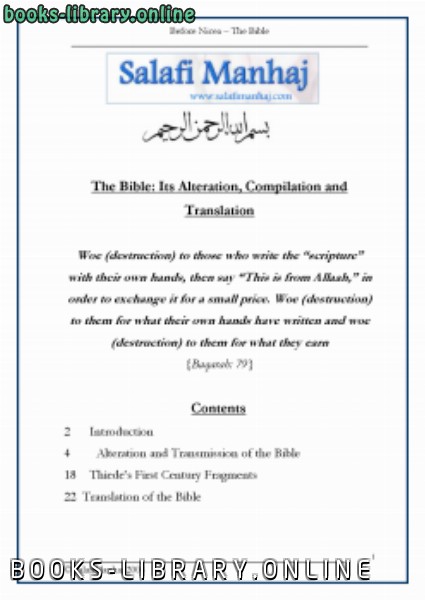📘 قراءة كتاب Befor Nicea The Bible أونلاين


2 Introduction
4 Alteration and Transmission of the Bible
18 Thiede’s First Century Fragments
22 Translation of the Bible
Alteration and Transmission of the Bible
Theologians recognize that the Bible contains many
contradictions and prefer not to explain them away as some
do. Simply, they accept this fact, often without a rejection of
their belief. It is such honesty that accounts for the large
number of Christian scholars looking into the origins of their
religion.
After listing many examples of contradictions in the Bible, Dr
Frederic Kenyon says: “Besides the larger discrepancies,
such as these contradictions, there is scarcely a verse in
which there is not some variation of phrase in some
copies (of ancient manuscripts from which the Bible has
been collected). No one can say that those additions or
omissions or alterations are matters of mere
indifference.”4
________________________________________________________
___________________________________________________________
It is in the preface of the Revised Standard Version of the Bible,
1978, that thirty-two Christian scholars “of the highest
eminence,” backed by fifty Christian denominations,
wrote of the authorized version, also known as the King James
Version, that: “The King James Version has grave defects,
so many and so serious as to call for revision.”
In 1957, the Jehovah’s Witnesses published the headline
“50,000 errors in the Bible” in their AWAKE magazine
writing: “There are probably 50,000 errors in the Bible, errors
which have crept into the Bible text.” 5 Nevertheless, they go
on to say, “as a whole the Bible is still accurate.” ?!
In The Story of the Manuscripts, the Reverend George E. Mernil
quotes Professor Arnold as stating: “There are not more than
1500 to 2000 places in which there is any uncertainty
whatever as to the true text.”
The Five Gospels written by the ‘Jesus Seminar,’ a group of
seventy four renowned Christian scholars from biblical
________________________________________________________
___________________________________________________________
studies institutes and universities all over the world,
6
was
the result of six years of dedicated study.
Deciding to produce a translation of the gospels which would
not be biased by their personal Christian faith, they
endeavored to discover the true words of Jesus in the Bible.
From the whole text they selected those passages that they
believed were the valid sayings of Jesus, and colour-coded
them.
Although we have reservations about their elimination of
longer passages which ignores the oral cultures’ memorization
ability, as well as the Jesus Seminar’s tendency to equate the
miraculous with myth, their conclusion was that: “82% of the
words ascribed to Jesus in the gospels were not actually
spoken by him.”7
They go on to say: “Biblical scholars and theologians alike
have learned to distinguish the Jesus of history from the
Christ of faith. It has been a painful lesson for both the
church and scholarship. The distinction between the two
6
Jesus Seminar, Robert W. Funk and Roy W. Hoover (translators and eds.), The Five Gospels (1993),
pp.533-537
________________________________________________________
___________________________________________________________
figures is the difference between a historical person who
lived in a particular time and place and a figure who has
been assigned a mythical role, in which he descends
from heaven to rescue mankind and, of course,
eventually return there.”
The quotes above are merely the authors’ opinions, the
second quote about the mythical role can be understood from
the fact that the concept of Jesus in Christianity is largely
based on pagan Roman mythical characters and this will be
addressed in a following chapter.
From the Jesus Seminar is an archaeological fact that is far
more important than what can be regarded as ‘their opinion’:
________________________________________________________
“In fact we do not have original copies of any of the
gospels. We do not posses autographs of any of the
books of the entire Bible. The oldest surviving copies of
the gospels date from about 175 years after the death of
Jesus, and no two copies are precisely alike. And
handmade manuscripts have almost always been
“corrected” here and there, often by more than one
hand. Further, this gap of almost two centuries means
that the original Greek (or Aramaic) text was copied
___________________________________________________________
more than once, by hand before reaching the stage in
which it has come down to us.”8
“The oldest copies of any substantial portion of the
Greek gospels still in existence – so far as we know –
date to about 200 C.E. However, a tiny fragment of the
Gospel of John can be dated to approximately 125 C.E.
or earlier, the same approximate date as the fragments of
the Egerton Gospel (Egerton is the name of the donor).
But these fragments are too small to afford more than
tiny apertures onto the history of the text. Most of the
important copies of the Greek gospels have been
“unearthed” – mostly in museums, monasteries, and
church archives – in the 19th and 20th centuries.”
They finally sum up this issue by saying: “...the stark truth is
that the history of the Greek gospels, from their creation
in the first century until the discovery of the first copies
at the beginning of the third century, remains largely
unknown and therefore unmapped territory.”9
_________________________________________________________
Peake’s Commentary of the Bible notes: “It is well known that
the primitive Christian Gospel was initially transmitted
by word of mouth and that this oral tradition resulted in
variant reporting of word and deed. It is equally true that
when the Christian record was committed to writing, it
continued to be the subject of verbal variation,
involuntary and intentional, at the hands of scribes and
editors.”10
Encyclopedia Brittanica highlights: “Yet, as a matter of fact,
every book of the New Testament, with the exception of
the four great Epistles of St. Paul is at present more or less
the subject of controversy and interpolations (inserted
verses) are asserted even in these.”11
After listing many examples of contradictory statements in the
Bible, Dr Frederic Kenyon states: “Besides the larger
discrepancies, such as these, there is scarcely a verse in
which there is not some variation of phrase in some
copies (of the ancient manuscripts from which the Bible
has been collected). No one can say that these additions
10Peake’s Commentary on the Bible, p.633
_________________
___________________________________________________________
or omissions or alterations are matters of mere
indifference.”12
Ehrman mentions: “In any event, none of the original
manuscripts of the books of the Bible now survive. What
do survive are copies made over the course of centuries,
or more accurately, copies of the copies of the copies,
some 5366 of them in the Greek language alone, that
date from the second century down to the sixteenth.
Strikingly, with the exception of the smallest fragments,
no two of these copies are exact. No one knows how
many different, or variant readings, occur among the
surviving witnesses, but they must number in the
hundreds of thousands.”13
The book begins with the introduction of the Salafist curriculum, one of the most prominent studies of the Gospels. The book begins by highlighting the circulation and transmission of the Gospel and when it was. Then, it tells us about the translation of the Gospel, the first century, , And so the author traces the historical line, to the current picture reached by the Gospels with time.
حجم الكتاب عند التحميل : 190.9 كيلوبايت .
نوع الكتاب : pdf.
عداد القراءة:
اذا اعجبك الكتاب فضلاً اضغط على أعجبني و يمكنك تحميله من هنا:

شكرًا لمساهمتكم
شكراً لمساهمتكم معنا في الإرتقاء بمستوى المكتبة ، يمكنكم االتبليغ عن اخطاء او سوء اختيار للكتب وتصنيفها ومحتواها ، أو كتاب يُمنع نشره ، او محمي بحقوق طبع ونشر ، فضلاً قم بالتبليغ عن الكتاب المُخالف:
 قبل تحميل الكتاب ..
قبل تحميل الكتاب ..
يجب ان يتوفر لديكم برنامج تشغيل وقراءة ملفات pdf
يمكن تحميلة من هنا 'http://get.adobe.com/reader/'


 منصّة المكتبة
منصّة المكتبة 